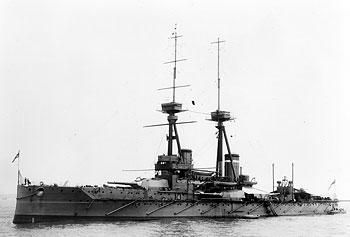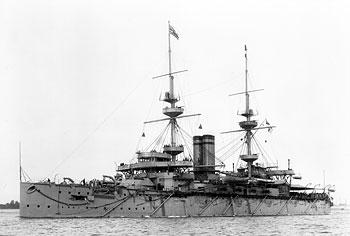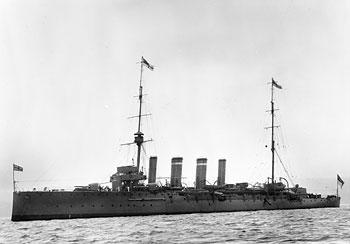Guy Florance Bikersteth Ottley was the younger brother of Desmond B Ottley who is also listed on the Winkleigh Roll of Honour. Guy was born in Eastbourne on the eve of the 1891 census and is listed as 20 hours old and “infant unnamed male”. It is possible to imagine that as his parents Henry and Marion already had four sons, Fielding, Laurence, Desmond and Fitz Roy (who had died very young) and only one daughter, Margaret, that they had anticipated another girl. Henry had come from a church family in Yorkshire and became the vicar of St Margarets Ilkley and called himself a clerk in Holy Orders. The family moved initially to Lincolnshire and then frequently including to Horsham where Desmond was born before moving to London and Croydon and then to Eastbourne. Guy’s parents eventually retired to Kensington. When Guy was nearly ten years old he was at a boarding school in Eastbourne.
Unlike two of his brothers, Guy did not make the church his profession. Instead, he joined the Navy on 15th September 1903 and passed out as a Midshipman in May 1908 at the age of 17. He may have taken note that his brother Laurence had started his education at Eastmans Royal Navy Academy in Titchmarch, although he later emigrated to Canada. He became a fruit grower, but eventually returned to England and married Rosamond Leir about 1936. In the 1911 census, Guy is recorded as a midshipman aboard the HMS Collingwood in Dartmouth. The Collingwood was first commissioned into the Navy on 3rd May 1910 in Portsmouth and was a St. Vincent class Dreadnought built in response to the planned building of German dreadnoughts which was perceived as a potential threat to Great Britain’s naval security. As a result, the Collingwood was larger and more powerful than the previous Bellerophon class. She had 10 12-inch guns with 18 4-inch quick firing secondary or anti-torpedo guns, although there were changes made during the war. She also had three torpedo tubes that fired below the waterline. The main waterline belt along the side was 10 inches thick, although the thickness toward the prow and the stern was much thinner. The propulsion was four Parsons steam turbines giving a top design speed of 18 knots. After a slow start, Guy completed his training and was made a Sub-Lieutenant on 30 August 1911 with the comment that he should make a good officer.
The Collingwood was first commissioned into the Navy on 3rd May 1910 in Portsmouth and was a St. Vincent class Dreadnought built in response to the planned building of German dreadnoughts which was perceived as a potential threat to Great Britain’s naval security. As a result, the Collingwood was larger and more powerful than the previous Bellerophon class. She had 10 12-inch guns with 18 4-inch quick firing secondary or anti-torpedo guns, although there were changes made during the war. She also had three torpedo tubes that fired below the waterline. The main waterline belt along the side was 10 inches thick, although the thickness toward the prow and the stern was much thinner. The propulsion was four Parsons steam turbines giving a top design speed of 18 knots. After a slow start, Guy completed his training and was made a Sub-Lieutenant on 30 August 1911 with the comment that he should make a good officer.
Guy’s active career started on the battleship HMS Hibernia of the Home Fleet until she was moved to Sheerness for aviation experiments. Guy was then transferred for three months to Triumph, a second-class battleship with the Mediterranean Fleet, where it was reported that Guy could speak French. This was followed by a period on depot ships in Malta where he was promoted to Lieutenant (E) which was confirmed in July 1912, and subsequently was transferred back to battleships. On 1st February 1913 he was sent to HMS Monarch for further engineering training, which continued on other ships and places.
Although the Winkleigh Roll of Honour associates Guy Ottley with HMS Hannibal, he was onboard for only a short time after he passed his Engineering Preliminary. HMS Hannibal was a Majestic class battleship and was commissioned in 1898. In 1906 she was converted from coal to fuel oil because of the high fuel consumption. She had four 12-inch guns and the saving in weight from previous guns permitted her to carry and additional twelve 6-inch guns together with sixteen 12-pounders and twelve 3-pounders and five torpedo tubes, and had a top speed of 13 knots. After serving in the Atlantic and around the coast, she was serving as a guard ship on the Humber with other ships to protect the English coast as a precautionary measure. Guy completed his training on the Hannibal on the first of July and took up his duties as an Engineer Lieutenant. The Great War started on the 28th and Britain declared war on 4th August 1914 and the Hannibal was moved to Scapa Flow that month. Guy left the Hannibal, presumably for ten days leave, to join the Princess Royal on 1st October. As Majestic class ships were now the oldest and least effective battleships in service, the Hannibal was largely disarmed and laid up until September 1915. Then she served as a troopship in the Dardanelles campaign in October. In November she became a depot ship for auxiliary patrol craft at Alexandria, supporting forces in Egypt and the Red Sea until June 1919.
he was onboard for only a short time after he passed his Engineering Preliminary. HMS Hannibal was a Majestic class battleship and was commissioned in 1898. In 1906 she was converted from coal to fuel oil because of the high fuel consumption. She had four 12-inch guns and the saving in weight from previous guns permitted her to carry and additional twelve 6-inch guns together with sixteen 12-pounders and twelve 3-pounders and five torpedo tubes, and had a top speed of 13 knots. After serving in the Atlantic and around the coast, she was serving as a guard ship on the Humber with other ships to protect the English coast as a precautionary measure. Guy completed his training on the Hannibal on the first of July and took up his duties as an Engineer Lieutenant. The Great War started on the 28th and Britain declared war on 4th August 1914 and the Hannibal was moved to Scapa Flow that month. Guy left the Hannibal, presumably for ten days leave, to join the Princess Royal on 1st October. As Majestic class ships were now the oldest and least effective battleships in service, the Hannibal was largely disarmed and laid up until September 1915. Then she served as a troopship in the Dardanelles campaign in October. In November she became a depot ship for auxiliary patrol craft at Alexandria, supporting forces in Egypt and the Red Sea until June 1919.
Princess Royal was a battlecruiser which was of a class designed in response to the German battlecruisers, and had been commissioned in 1913. She was 700 feet long with a top speed of 28 knots and had 4 × 2 – BL 13.5-inch Mk V guns, 16 × 1 – BL 4-inch Mark VII guns and 2 × 1 – 21-inch Mk II submerged torpedo tubes. She was sent to the Caribbean to prevent the German East Asia Squadron from using the Panama Canal. However, after the disastrous Battle of Coronel, the large Geman squadron of cruisers neaded by the SMS Scharnhorst was beaten at the Battle of Falkland on 8 December 1914 by a larger British squadron of battlecruisers and cruisers, and the Princess Royal then returned to the 1st Battle Squadron
On 24th January 1915, the Pricesss Royal was at the Battle of Dogger. As the German Navy had been having much success, they had started to attack the English coast and decided to attack fishing vessels around Dogger. The British knew of the attack and intercepted the German fleet. The Princess Royal disabled SMS Blücher which was eventually sunk, but the Battle was not a real success because of misunderstandings and equipment. The German force was able to return to port albeit with some damage. Shortly afterwards the Princess Royal became the flagship of the 1st Batllecruiser Squadron.
On 24 November 1915,  Guy joined HMS Falmouth which was a Town class light cruiser commissioned on 1st January 1911 and had had eight 6-inch guns, four 3 pounders and two submerged torpedo tubes, with a top speed of 25 knots. She become the flagship of the 1st Light Cruiser Squadron but was now in the 3rd Light Cruiser Squadron at Rosyth. Prior to this, she had sunk four German ships within the first month of the blockade of German shipping after letting their crews abandon ship. Then she took part in the Battles of Heligoland and of Dogger as part of the 1st Light Cruiser Squadron. At the end of May 1916 she was sent with the Grand Fleet to the coast of Denmark off Jutland, where a large number of German ships were being concentrated while being blockaded by the Royal Navy. The German hope was that the concentration of ships would lure the Royal Navy’s Grand Fleet, so many could be destroyed and allow Germany’s mercantile fleet to operate. It was also part of a larger strategy to brake the British blockage of Germany. The Grand Fleet was sent to Jutland in May 1916. The Battle of Jutand took place on 31st May and 1st June and was the largest sea battle ever, before or since, with a total of 250 ships. During the night of 31st May, the British manoeuvred to restart the battle in the morning, but possibly because of poor intelligence from the Admiralty, the German fleet managed to return to port. However, the result of the battle was indecisive and still remains a contested issue. Germany failed to destroy a substantial part of the British fleet, but the British lost more ships and twice as many sailors.
Guy joined HMS Falmouth which was a Town class light cruiser commissioned on 1st January 1911 and had had eight 6-inch guns, four 3 pounders and two submerged torpedo tubes, with a top speed of 25 knots. She become the flagship of the 1st Light Cruiser Squadron but was now in the 3rd Light Cruiser Squadron at Rosyth. Prior to this, she had sunk four German ships within the first month of the blockade of German shipping after letting their crews abandon ship. Then she took part in the Battles of Heligoland and of Dogger as part of the 1st Light Cruiser Squadron. At the end of May 1916 she was sent with the Grand Fleet to the coast of Denmark off Jutland, where a large number of German ships were being concentrated while being blockaded by the Royal Navy. The German hope was that the concentration of ships would lure the Royal Navy’s Grand Fleet, so many could be destroyed and allow Germany’s mercantile fleet to operate. It was also part of a larger strategy to brake the British blockage of Germany. The Grand Fleet was sent to Jutland in May 1916. The Battle of Jutand took place on 31st May and 1st June and was the largest sea battle ever, before or since, with a total of 250 ships. During the night of 31st May, the British manoeuvred to restart the battle in the morning, but possibly because of poor intelligence from the Admiralty, the German fleet managed to return to port. However, the result of the battle was indecisive and still remains a contested issue. Germany failed to destroy a substantial part of the British fleet, but the British lost more ships and twice as many sailors.
Although the Falmouth was hit by a German shell at Jutland, she survived and was made the flagship of the squadron. During his time on Falmouth, Guy had two reports of his service which stated that he was “above average. A keen and capable officer for whom men work well” and “most zealous & capable carries out his duties of senior(e) with both tact & ability”. Six weeks after Jutland, HMS Falmouth joined part of the Grand Fleet again after the German fleet made another sortie into the North Sea. HMS Nottingham was sunk by a U-boat, so the fleet turned back to avoid a possible concentration of submarines. During the return journey the Falmouth was hit by a torpedo from submarine U66 on 19th August, but survived and was taken in tow. Later she was hit by a torpedo from another submarine and sank the next day off Flamborough Head. During these two days Guy Ottley’s actions warranted an official commendation.
Guy was then sent as an engineer to Pembroke to prepare for HMS Ceres which was being built on Clydebank. A year earlier his zeal and ingenuity had been appreciated when he had been part of a team evaluating a device for laying guns automatically, so his new placement would have been most suitable. The Ceres was a C class light cruiser and was commissioned on 1st June 1917 and was assigned to operate in the Mediterranean as part of the 3rd Cruiser Squadron. Guy continued to serve on the Ceres until 5th November 1917 when he was sent as an engineer to Chatham to prepare for HMS Tarpon. Two days later, it was announced that he had been awarded the Italian Silver Medal for Military Valour for his contribution during the two days on the Falmouth when it had been under attack from submarines and had sunk. Commander (E) George Scullard was also awarded the Italian Silver Medal for the same event. While at Chatham, Guy was granted permission to visit Switzerland from 20 December to 5th January 1918.
HMS Tarpon was an R class destroyer designed to be a mine layer and was commissioned in March 1918. She seems to have had a quiet life with only one noteworthy event when she hit a mine (one of her own?) and had to be towed into Dunkirk. The picture on the right shows her being towed int Dunkirk with a slight list, damage to her port side and with her stern just above the water. Guy continued his service on Tarpon until the end of the war.
On 1st November 1918 Guy started a course on instructing engineering at the RN College Greenwich which continued until the end of June 1920 followed by a further month of training in Portsmouth. On 1st August 1920 Guy was appointed Assistant to the Engineer Manager at Rosyth. However, his report in January, which continued to say that he was zealous, hardworking and showed great promise, also reported that he was suffering from shock (due to war service experiences & strain of long course at Greenwich, probably). Otherwise, he was of good character, had mental qualities of a high order, normally good physique, tactful, most zealous & anxious to excel, and has very good administrative qualities. He was visited at his home in January 1921 and was found unfit for service with Neurasthenia and was given two months before a resurvey at Chatham if fit to travel. He was resurveyed and recommended further observation and treatment in hospital. After dismissal from hospital and three weeks recovery time, he was found fit at Chatham in mid April.
In July he went to Pembroke for Instructor of Mechanical Training until February 1921 when he took up his post as instructor at the RN Engineering College at Keyham, which he kept until late 1924. His last report there shows that he was above average for everything except amateur theatricals. He had abundant vitality, gent personality, considerable influence, good organising ability, takes great pains organising entertainment, dances etc.
After a month of instructional duties in Devonport, Guy went back to sea on HMS Marlborough on 22nd September 1924. The Marlborough was a battleship of the Iron Duke class and commissioned in June 1914 and her armament was 10 × BL 13.5-inch (342.9 mm) /45 guns in five twin turrets, 12 × BL 6-inch (152.4 mm) /45 Mk VII guns in single casemate mountings, 2 × QF 3 inch 20 cwt anti-aircraft guns and 4 × 21 inch submerged beam torpedo tubes. She was 622 feet 9 inches long and her 4 shaft Parsons steam turbines, driving four propellers, 18 Babcock & Wilcox or Yarrow boilers delivering 29,000 hp gave her a top speed of 21.25 knots (39.35 km/h). She had been at the Battle of Jutland and fired 162 shells, but was hit by a torpedo. In 1919, during the Russian Civil War the Marlborough was on duty in the Black Sea. On orders of King George V, the ship rescued his aunt, Dowager Empress Maria Feodorovna, and other members of the Russian Imperial Family, including Grand Duke Nicholas and Prince Felix Yusupov.
While on the Marlborough, Guy was promoted to Commander (E) on 31st December 1925. After three weeks leave, Guy went back to Pembroke on 26 March 1926 and his record of service was closed on 1st October 1926.
It is unlikely that Guy lived in Winkleigh, but must have been a regular visitor to his brother Desmond when on leave. Desmond was the curate in Winkleigh and had married Eva Glover, who joined the VAD and is aslo listed on the Winkleigh Roll of Honour. Guy is mentioned in the Chulmleigh Deanery magazine as well as being listed on the Winkleigh Roll of Honour so must have been considered as being resident in Winkleigh. Nothing is known of what became of Guy after he left the Navy. However, in 1935 Guy F B Ottley was presented with the Jubilee Medal and then the King George VI Coronation Medal in 1937.
3 March 2012


